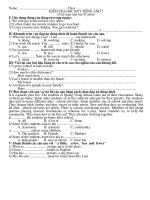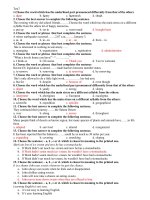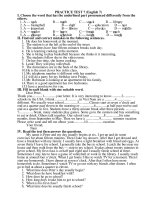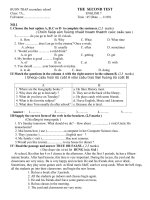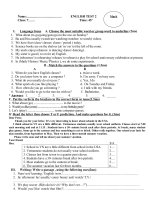Physics section test (7)
Bạn đang xem bản rút gọn của tài liệu. Xem và tải ngay bản đầy đủ của tài liệu tại đây (172.43 KB, 11 trang )
MCAT Section Tests
Dear Future Doctor,
The following Section Test and explanations should be used to practice and to assess
your mastery of critical thinking in each of the section areas. Topics are confluent and
are not necessarily in any specific order or fixed proportion. This is the level of
integration in your preparation that collects what you have learned in the Kaplan
classroom and synthesizes your knowledge with your critical thinking.
Simply
completing the tests is inadequate; a solid understanding of your performance through
your Score Reports and the explanations is necessary to diagnose your specific
weaknesses and address them before Test Day.
All rights are reserved pursuant to the copyright laws and the contract clause in your
enrollment agreement and as printed below. Misdemeanor and felony infractions can
severely limit your ability to be accepted to a medical program and a conviction can
result in the removal of a medical license. We offer this material for your practice in your
own home as a courtesy and privilege. Practice today so that you can perform on test
day; this material was designed to give you every advantage on the MCAT and we wish
you the best of luck in your preparation.
Sincerely,
Albert Chen
Executive Director, Pre-Health Research and Development
Kaplan Test Prep
© 2003 Kaplan, Inc.
All rights reserved. No part of this book may be reproduced in any form, by Photostat, microfilm,
xerography or any other means, or incorporated into any information retrieval system, electronic
or mechanical without the written permission of Kaplan, Inc. This book may not be duplicated,
distributed or resold, pursuant to the terms of your Kaplan Enrollment Agreement.
Physical Sciences
Test 4
Time: 35 Minutes
Number of Questions: 27
MCAT
PHYSICAL SCIENCES
DIRECTIONS: Most of the questions in the following
Physical Sciences test are organized into groups, with
a descriptive passage preceding each group of
questions. Study the passage, then select the single
best answer to each question in the group. Some of
the questions are not based on a descriptive passage;
you must also select the best answer to these
questions. If you are unsure of the best answer,
eliminate the choices that you know are incorrect,
then select an answer from the choices that remain.
Indicate your selection by blackening the
corresponding circle on your answer sheet. A periodic
table is provided below for your use with the
questions.
PERIODIC TABLE OF THE ELEMENTS
1
H
1.0
2
He
4.0
3
Li
6.9
4
Be
9.0
5
B
10.8
6
C
12.0
7
N
14.0
8
O
16.0
9
F
19.0
10
Ne
20.2
11
Na
23.0
12
Mg
24.3
13
Al
27.0
14
Si
28.1
15
P
31.0
16
S
32.1
17
Cl
35.5
18
Ar
39.9
19
K
39.1
20
Ca
40.1
21
Sc
45.0
22
Ti
47.9
23
V
50.9
24
Cr
52.0
25
Mn
54.9
26
Fe
55.8
27
Co
58.9
28
Ni
58.7
29
Cu
63.5
30
Zn
65.4
31
Ga
69.7
32
Ge
72.6
33
As
74.9
34
Se
79.0
35
Br
79.9
36
Kr
83.8
37
Rb
85.5
38
Sr
87.6
39
Y
88.9
40
Zr
91.2
41
Nb
92.9
42
Mo
95.9
43
Tc
(98)
44
Ru
101.1
45
Rh
102.9
46
Pd
106.4
47
Ag
107.9
48
Cd
112.4
49
In
114.8
50
Sn
118.7
51
Sb
121.8
52
Te
127.6
53
I
126.9
54
Xe
131.3
55
Cs
132.9
56
Ba
137.3
57
La *
138.9
72
Hf
178.5
73
Ta
180.9
74
W
183.9
75
Re
186.2
76
Os
190.2
77
Ir
192.2
78
Pt
195.1
79
Au
197.0
80
Hg
200.6
81
Tl
204.4
82
Pb
207.2
83
Bi
209.0
84
Po
(209)
85
At
(210)
86
Rn
(222)
87
Fr
(223)
88
Ra
226.0
89
Ac †
227.0
104
Unq
(261)
105
Unp
(262)
106
Unh
(263)
107
Uns
(262)
108
Uno
(265)
109
Une
(267)
*
58
Ce
140.1
59
Pr
140.9
60
Nd
144.2
61
Pm
(145)
62
Sm
150.4
63
Eu
152.0
64
Gd
157.3
65
Tb
158.9
66
Dy
162.5
67
Ho
164.9
68
Er
167.3
69
Tm
168.9
70
Yb
173.0
71
Lu
175.0
†
90
Th
232.0
91
Pa
(231)
92
U
238.0
93
Np
(237)
94
Pu
(244)
95
Am
(243)
96
Cm
(247)
97
Bk
(247)
98
Cf
(251)
99
Es
(252)
100
Fm
(257)
101
Md
(258)
102
No
(259)
103
Lr
(260)
GO ON TO THE NEXT PAGE.
2
as developed by
Physical Sciences 4
Passage I (Questions 1–5)
1.
When light enters the eye, it forms an image on
the retina. First, light from the object passes through
the cornea, a converging lens within the eye, and then
through a liquid known as the aqueous humor. After
this it passes through a second crystalline converging
lens into the eyeball, which is filled with a fluid
known as the vitreous humor. The light is refracted by
the cornea and by the crystalline lens, and is focused
on the retina, which transmits electrical impulses
along
the
optic
nerve
to
the
brain
The index of refraction of the vitreous humor is
greater than the index of refraction of the
aqueous humor which is greater than the index of
refraction of air. What is the relationship of the
speed of light in each of these media?
A. fastest in air, slower in aqueous humor,
slowest in vitreous humor
B. fastest in vitreous humor, slower in aqueous
humor, slowest in air
C. equal in all three
D. depends on the index of refraction of the
lenses which separate the media
2.
In myopia, or nearsightedness, the light converges
too soon, causing the image of an object at
infinity to be focused before the retina. Which of
the following offers a plausible explanation of
the underlying reason for myopia?
A. The ciliary muscle cannot tense up
sufficiently.
B. The ciliary muscle cannot relax sufficiently.
C. The aqueous humor absorbs too much light.
D. The aqueous humor does not absorb enough
light.
The cornea has a constant focal length, and is
responsible for most of the refraction of the light
from the object. The crystalline lens has a variable
focal length, which enables the eye to focus the image
on the retina, even though the object distance varies.
The focal length of the crystalline lens is varied by
tensing and relaxing the ciliary muscle that surrounds
the lens. It is relaxed when focusing on a distant
object, and tensed when focusing on a near object. It is
important to note that when the ciliary muscle is
tensed, the lens assumes a more spherical shape, thus
decreasing the focal length.
The cornea and the crystalline lens may be
considered two thin lenses in contact, and therefore
thought of as a single converging lens at a distance of
2.0 centimeters from the retina. When an object is at
an infinite distance away, the focal length of the lens
is equal to the distance between the lens and the retina
When the distance to the object is appreciably smaller,
the focal length of the lens changes so that the image
is still focused on the retina.
3.
Hyperopia, or farsightedness, is caused when an
object at infinity is focused behind the retina. In
order to correct hyperopia, which of the
following lens types would be the most
appropriate?
A.
C.
B.
D.
GO ON TO THE NEXT PAGE.
KAPLAN
3
MCAT
4.
A myopic person’s eye has a relaxed focal length
of 1.9 cm. What is the maximum distance from
the eye at which she can see an object clearly, and
what is the magnification of the lens for an object
at this point?
A. O = 1 cm, m =
5.
1
2
1
B. O = 38 cm, m =
-
C. O = 38 cm, m =
-
D. O = 50 cm, m =
-
38
1
19
1
A.
B.
C.
D.
I only
I and II only
II and III only
I, II, and III
A mixture of two volatile solvents that exhibits
ideal behavior will boil when the total vapor pressure
is equal to the atmospheric pressure. The
concentration of the more volatile component will
always be greater in the vapor than in the solution. If
the vapor above the boiling mixture is condensed and
boiled again, it will be even richer in the more volatile
component. With successive condensations and
boilings, it is possible to separate the individual
components. This process is known as fractional
distillation.
50
Which of the following is true of the image
formed on the retina?
I. It is real.
II. It is inverted.
III. It is reduced.
Passage II (Question 6–11)
There are, however, a number of solvent systems
that do not behave ideally, and consequently cannot be
separated. Figure 1 shows a boiling-point diagram for
a system that is called a minimum-boiling azeotrope.
In a system such as this, the attraction between unlike
molecules is weaker than the attraction between like
molecules; as a result, the solution boils at a lower
temperature than the pure components. Systems that
have a maximum on the boiling-point diagram are
called maximum-boiling azeotropes. Fractional
distillation of these non-ideal systems will, at best,
give one pure component and the azeotrope.
GO ON TO THE NEXT PAGE.
4
as developed by
Physical Sciences 4
6.
Which of the following best describes the
mechanism by which two substances form a
maximum-boiling azeotrope?
9.
A. Each substance increases the specific heat of
the other.
B. Each substance decreases the specific heat of
the other.
C. Each substance increases the vapor pressure
of the other.
D. Each substance decreases the vapor pressure
of the other.
A.
B.
C.
D.
10
7.
Which of the following combinations would be
likely to form a minimum-boiling azeotrope?
A.
B.
C.
D.
8.
0.04 or 0.70
0.20 or 0.40
0.30 or 0.96
0.60 or 0.80
An ethanol and water solution can be distilled to,
at best, a 95% ethanol solution, which boils at
78°C. What can be said about this mixture?
A. It is a minimum-boiling azeotrope with
water as the most volatile component.
B. It is a minimum-boiling azeotrope with
ethanol as the most volatile component.
C. It is a maximum-boiling azeotrope with
water as the most volatile component.
D. It is a maximum-boiling azeotrope with
ethanol as the most volatile component.
Water and chlorobenzene
Water and nitric acid
Water and hydrogen peroxide
Water and acetone
Which of the following shows the boiling point
of an aqueous sodium chloride solution as a
function of the percent sodium chloride in the
solution by weight?
Based on Figure 1, if a mixture of Solution A and
Solution B boils at 40°C, what is the mole
fraction of B in the vapor?
11
Which of the following describes the effect on
boiling point when a nonvolatile solute is added
to a liquid?
A.
B.
C.
D.
∆Tb = KbM
∆Tb = Kb / M
∆Tb = Kbm
∆Tb = Kb / m
GO ON TO THE NEXT PAGE.
KAPLAN
5
MCAT
Passage III (Questions 12–17)
Robert Millikan is credited with showing
experimentally that the electron has a definite, finite
charge. His experiment, in a somewhat simplified
form, is described below. The setup is shown in
Figure 1.
12. What is the electric field between the plates in
Figure 1 if the voltage VAB is 20 volts?
A. 0.02 V/m
B. 0.2 V/m
C. 20 V/m
D. 2 x 103 V/m
13. What is the direction of an electric field between
the plates that holds a negatively charged droplet
motionless?
A.
B.
C.
D.
Two horizontal parallel plates, A and B. are
placed 1 cm apart, and are insulated from one another.
A potential difference VAB is applied across the
plates, producing an electric field between them.
Drops of oil between 10–6 and 10–5 cm in
diameter are sprayed through a hole in the top plate
into the electric field. The drops accumulate electric
charge, and are therefore affected by the electric field.
In the case of a negatively-charged drop, the potential
difference across the plates is adjusted until the drop
is motionless, the gravitational force being exactly
balanced by the upward electrostatic force. The mass
of the droplet and the potential difference across the
plates is measured, and from this the electric charge
on the drop can be determined. This procedure is then
repeated with another drop.
Millikan found, when he calculated the electric
charge required from the balanced forces, that the
measured charges were integer multiples of a specific
electric charge. This “unit” charge was assumed to be
the charge of a single electron. (Note: acceleration
due to gravity = 9.8 m/s2; density of oil = 800 kg/m3.)
Upwards
Downwards
To the left
To the right
14. If the separation of the plates is reduced, but the
potential difference across them remains
constant, which of the following statements must
be true?
I. The electric field increases.
II. The magnetic field increases.
III. The capacitance increases.
A.
B.
C.
D.
I only
I and II only
I and III only
II ant III only
15. An oil drop is stationary within an electric field
of E that is set up between two parallel plates. If
the oil drop has a volume of V and a density of ρ,
how many excess electrons does it carry? (Note:
The fundamental unit of charge is e.)
A.
B.
C.
D.
E/ρgV
eE/ρgV
ρgV/E
ρgV/eE
GO ON TO THE NEXT PAGE.
6
as developed by
Physical Sciences 4
16. A negatively charged droplet has a mass of 5 x
10–16 kg and carries a charge of 8 x 10–18 C. The
droplet falls through the hole in the upper plate
when the electric field is 0 V/m. How does the
drop move within the plates as the electric field is
increased slowly from 0 V/m to 800 V/m? (Note:
Assume that the drop remains between the plates
at all times.)
A. It moves downwards, stops, then moves
upwards.
B. It moves downwards, accelerating all the
time.
C. It moves downwards, stops, then moves
downwards again.
D. It moves downwards, stops, and remains
stationary.
.
17. A drop of oil of mass 5 x 10–16 kg is at rest on
the bottom of a plate of a parallel plate
combination when the electric field is zero. An
electric field of 4 x 103 V/m is then applied
between the plates, accelerating the drop towards
the top plate. What will be the resultant
acceleration of the drop if it carries a negative
charge of 3 x 10-18 C?
A. 9.8 m/s2
B. 14.2 m/s2
C. 24.0 m/s2
D. 28.4 m/s2
Questions 18 through 22 are
NOT based on a descriptive
passage.
18. What is the calcium concentration of a solution
formed by adding 1 mol of CaCl2 to 1 L of
distilled water at 298K?
A.
B.
C.
D.
1M
1m
2M
2m
19. Two blocks of the same density are completely
submerged in water. One block has a mass equal
to m and volume equal to V. The other has a mass
equal to 2m. What is the ratio of the first block’s
apparent weight to the second block’s apparent
weight?
A.
B.
C.
D.
1:1
1:2
2:1
4:1
20. In which atomic orbital(s) to the alkaline earth
elements contain valence electrons?
A.
B.
C.
D.
s
d
s and d
s, d, and p
21. In the arrangement shown below, a current flows
from P to Q. Which of the following could
represent the current flowing through R1, R2, R3,
and R4, respectively?
R 1= R
R 3= 2R
P
Q
R 2= R
A.
B.
C.
D.
R 4= R
1.0 A, 2.0 A, 1.0 A, 2.0 A
1.0 A, 1.0 A, 0.5 A, 1.0 A
3.0 A, 3.0 A, 4.0 A, 2.0 A
3.0 A, 3.0 A, 2.0 A, 4.0 A
GO ON TO THE NEXT PAGE.
KAPLAN
7
MCAT
22. What is the ratio of the maximum possible
number of electrons in an f subshell to the
maximum number of electrons in a p subshell?
A. 2:1
B. 4:1
C. 7:3
D. 15:6
Passage IV (Questions 23–27)
A chemistry teacher wishes to set up a
demonstration of a redox reaction for her class.
Students are provided with the materials necessary to
set up the apparatus shown below.
Experiment 1: Students were provided with 1 M
hydrochloric acid and offered a choice of various
metals. The metals offered to the students, along with
their reduction potentials, are listed below.
Metal
E°(V)
Silver
Copper
Tin
Nickel
Iron
0.80
0.34
–0.14
–0.25
–0.44
Each student group tested a different metal for
reactivity by placing it in a beaker and observing the
gas produced (if any) from the reaction. Each metal’s
reaction was timed and the rate at which gas was
produced was recorded.
Experiment 2: Students were given the supplies
necessary to set up a galvanic cell for the purpose of
determining the reduction potential of zinc, also using
hydrochloric acid. The reduction potential was
determined to be –0.76V.
Both experiments were carried out at 25°C and
1 atm.
GO ON TO THE NEXT PAGE.
8
as developed by
Physical Sciences 4
23. When hydrochloric acid is added to each of the
metals listed in Table 1, which metals will
produce a reaction?
A.
B.
C.
D.
Ag, Cu
Sn, Ni, Fe
All of the metals
None of the metals
24. Of the metals listed, which will produce the most
vigorous reaction?
A.
B.
C.
D.
Silver
Copper
Tin
Iron
25. In Experiment 2, which of the following galvanic
cell setups would be most useful for determining
the reduction potential of zinc?
A. Zinc electrode as anode in a 1 M Zn2+
solution; hydrogen electrode as cathode in a
1 M H+ solution
B. Zinc electrode as cathode in a 1 M Zn2+
solution; hydrogen electrode as anode in a 1
M H+ solution
C. Zinc electrode as anode in a 1 M Zn2+
solution; copper electrode as cathode in a 1
M Cu 2+ solution
D. Zinc electrode as cathode in a 1 M Zn2+
solution; copper electrode as anode in a 1 M
Cu 2+ solution
26. What is the role of HCl in Experiment 2?
A.
B.
C.
D.
It is a reducing agent.
It is an oxidizing agent.
It is a catalyst.
It in a solvent.
27. If Experiment 1 were carried out using zinc, what
would be the maximum weight of the sample that
could be used to ensure that all the gas produced
could be collected in a 1 L bottle?
A.
B.
C.
D.
1.3 g
1.4 g
2.6 g
2.9 g
KAPLAN
END OF TEST
9
MCAT
ANSWER KEY:
1. A
11.
2. B
12.
3. B
13.
4. C
14.
5. D
15.
6.
7.
8.
9.
10.
10
D
A
B
B
B
16.
17.
18.
19.
20.
C
D
B
C
D
21.
22.
23.
24.
25.
A
B
B
B
A
26. B
27. C
D
C
B
D
A

